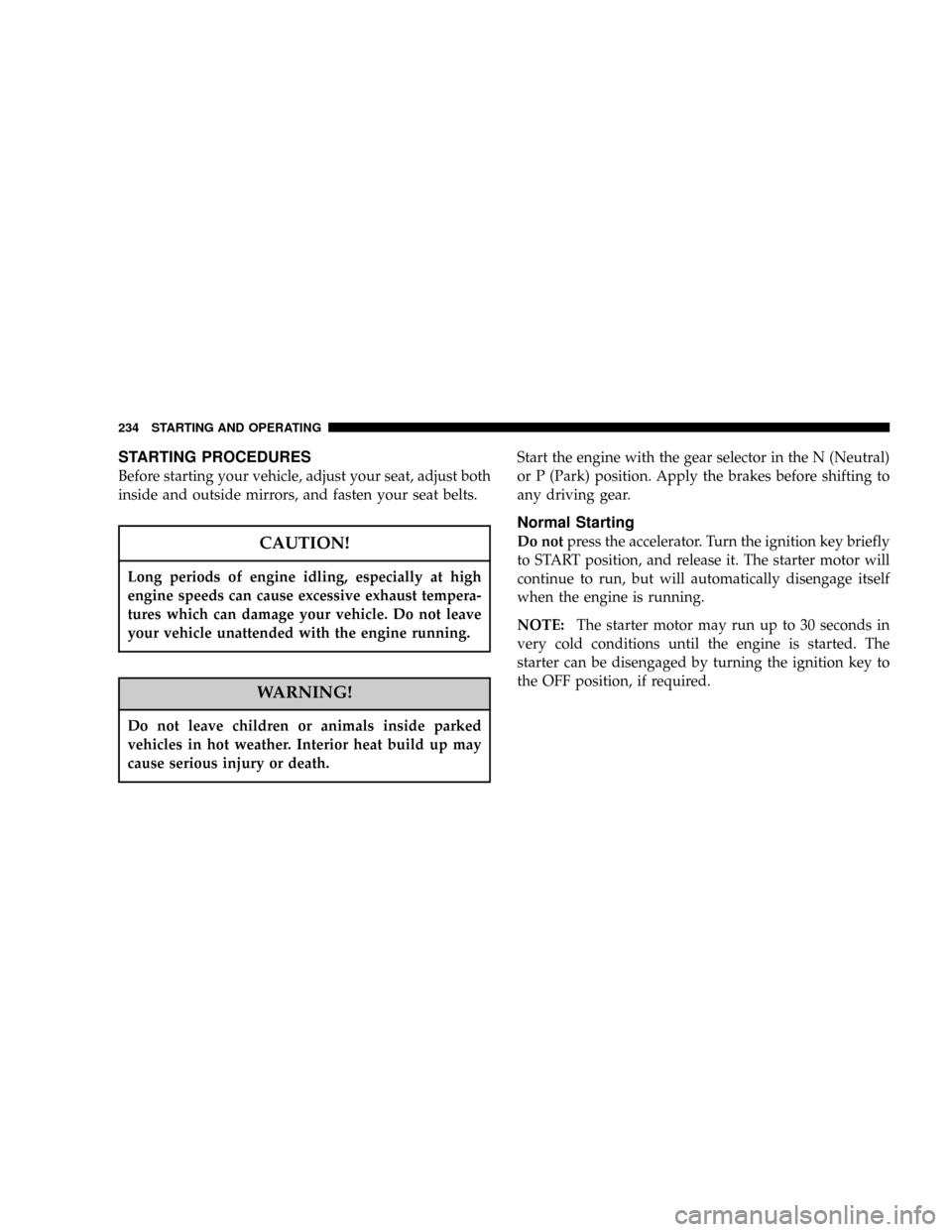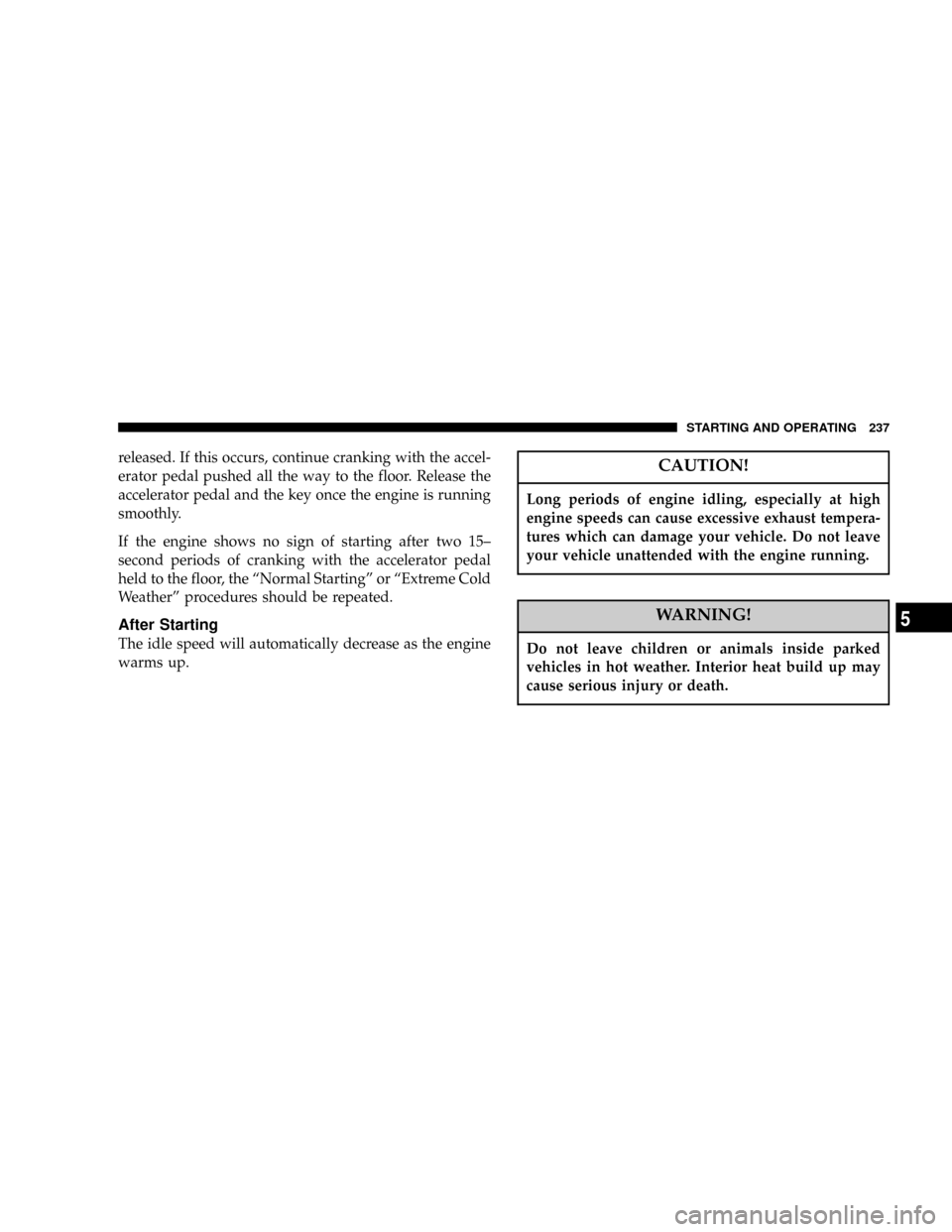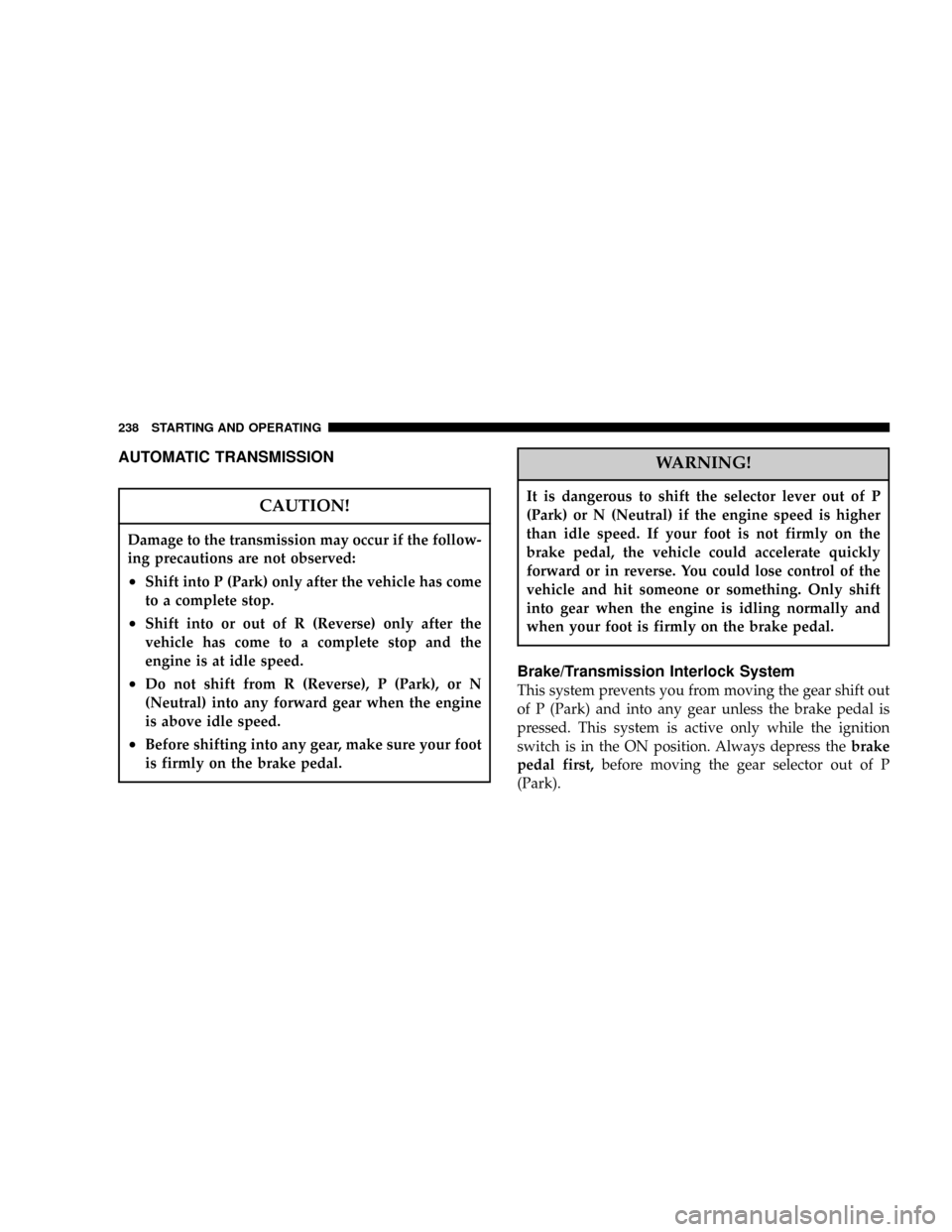JEEP GRAND CHEROKEE 2007 WK / 3.G SRT Owners Manual
Manufacturer: JEEP, Model Year: 2007, Model line: GRAND CHEROKEE, Model: JEEP GRAND CHEROKEE 2007 WK / 3.GPages: 395, PDF Size: 6.1 MB
Page 231 of 395

STARTING AND OPERATING
CONTENTS
mStarting Procedures.....................234
NNormal Starting......................234
NExtreme Cold Weather (Below ±20ÉF (±29ÉC) . . 235
NIf Engine Fails To Start.................235
NAfter Starting........................237
mAutomatic Transmission..................238
NBrake/Transmission Interlock System.......238
N5±Speed Automatic Transmission..........239
NGear Ranges.........................239NRocking The Vehicle...................241
mAutoStick............................241
NAutoStick Operation...................242
NAutoStick General Information............243
mParking Brake.........................244
mAnti-Lock Brake System..................245
mPower Steering........................248
mTire Safety Information...................250
NTire Markings........................250
5
Page 232 of 395

NTire Identification Number (TIN)..........253
NTire Loading And Tire Pressure...........254
mTires Ð General Information...............258
NRun Flat Tires........................258
NTire Pressure.........................258
NTire Inflation Pressures.................260
NTire Pressures For High Speed Operation....261
NRadial-Ply Tires......................262
NTire Spinning........................263
NTread Wear Indicators..................263
NLife Of Tire.........................264
NReplacement Tires.....................265
NAlignment And Balance.................266mTire Rotation Recommendations............266
mTire Pressure Monitor System (TPMS)........266
NPremium System......................266
NGeneral Information...................270
mFuel Requirements......................270
NReformulated Gasoline.................271
NGasoline/Oxygenate Blends..............271
NMMT In Gasoline.....................272
NMaterials Added To Fuel................272
NFuel System Cautions..................273
NCarbon Monoxide Warnings..............273
mAdding Fuel..........................274
NFuel Filler Cap (Gas Cap)...............274
232 STARTING AND OPERATING
Page 233 of 395

mTrailer Towing.........................277
NCommon Towing Definitions.............277
NTrailer Hitch Classification...............281
NTrailer Towing Weights
(Maximum Trailer Weight Ratings).........282NTrailer And Tongue Weight..............282
NTowing Requirements..................284
NTowing Tips.........................288
mRecreational Towing (Behind Motorhome, Etc.) . . 289
STARTING AND OPERATING 233
5
Page 234 of 395

STARTING PROCEDURES
Before starting your vehicle, adjust your seat, adjust both
inside and outside mirrors, and fasten your seat belts.
CAUTION!
Long periods of engine idling, especially at high
engine speeds can cause excessive exhaust tempera-
tures which can damage your vehicle. Do not leave
your vehicle unattended with the engine running.
WARNING!
Do not leave children or animals inside parked
vehicles in hot weather. Interior heat build up may
cause serious injury or death.
Start the engine with the gear selector in the N (Neutral)
or P (Park) position. Apply the brakes before shifting to
any driving gear.
Normal Starting
Do notpress the accelerator. Turn the ignition key briefly
to START position, and release it. The starter motor will
continue to run, but will automatically disengage itself
when the engine is running.
NOTE:The starter motor may run up to 30 seconds in
very cold conditions until the engine is started. The
starter can be disengaged by turning the ignition key to
the OFF position, if required.
234 STARTING AND OPERATING
Page 235 of 395

Extreme Cold Weather (below ±20ÉF (±29ÉC)
To insure reliable starting at these temperatures, use of an
externally powered electric engine block heater (available
from your authorized dealer) is recommended.
If Engine Fails to Start
If the engine fails to start after you have followed the
ªNormal Startingº or ªExtreme Cold Weatherº proce-
dures, it may be flooded. Push the accelerator pedal all
the way to the floor and hold it there while cranking the
engine. This should clear any excess fuel in case the
engine is flooded.
CAUTION!
To prevent damage to the starter, do not crank the
engine for more than 15 seconds at a time. Wait 10 to
15 seconds before trying again.
Ignition Key Positions
STARTING AND OPERATING 235
5
Page 236 of 395

WARNING!
Never pour fuel or other flammable liquids into the
throttle body air inlet opening in an attempt to start
the vehicle. This could result in a flash fire causing
serious personal injury.
WARNING!
Do not attempt to push or tow your vehicle to get it
started. Vehicles equipped with an automatic trans-
mission cannot be started this way. Unburned fuel
could enter the catalytic converter and once the
engine has started, ignite and damage the converter
and vehicle. If the vehicle has a discharged battery,
booster cables may be used to obtain a start from a
booster battery or the battery in another vehicle. This
type of start can be dangerous if done improperly.
Refer to Section 6 of this manual for proper jump
starting procedures and follow them carefully.
If the engine has been flooded, it may start to run, but not
have enough power to continue running when the key is
236 STARTING AND OPERATING
Page 237 of 395

released. If this occurs, continue cranking with the accel-
erator pedal pushed all the way to the floor. Release the
accelerator pedal and the key once the engine is running
smoothly.
If the engine shows no sign of starting after two 15±
second periods of cranking with the accelerator pedal
held to the floor, the ªNormal Startingº or ªExtreme Cold
Weatherº procedures should be repeated.
After Starting
The idle speed will automatically decrease as the engine
warms up.
CAUTION!
Long periods of engine idling, especially at high
engine speeds can cause excessive exhaust tempera-
tures which can damage your vehicle. Do not leave
your vehicle unattended with the engine running.
WARNING!
Do not leave children or animals inside parked
vehicles in hot weather. Interior heat build up may
cause serious injury or death.
STARTING AND OPERATING 237
5
Page 238 of 395

AUTOMATIC TRANSMISSION
CAUTION!
Damage to the transmission may occur if the follow-
ing precautions are not observed:
²Shift into P (Park) only after the vehicle has come
to a complete stop.
²Shift into or out of R (Reverse) only after the
vehicle has come to a complete stop and the
engine is at idle speed.
²Do not shift from R (Reverse), P (Park), or N
(Neutral) into any forward gear when the engine
is above idle speed.
²Before shifting into any gear, make sure your foot
is firmly on the brake pedal.
WARNING!
It is dangerous to shift the selector lever out of P
(Park) or N (Neutral) if the engine speed is higher
than idle speed. If your foot is not firmly on the
brake pedal, the vehicle could accelerate quickly
forward or in reverse. You could lose control of the
vehicle and hit someone or something. Only shift
into gear when the engine is idling normally and
when your foot is firmly on the brake pedal.
Brake/Transmission Interlock System
This system prevents you from moving the gear shift out
of P (Park) and into any gear unless the brake pedal is
pressed. This system is active only while the ignition
switch is in the ON position. Always depress thebrake
pedal first,before moving the gear selector out of P
(Park).
238 STARTING AND OPERATING
Page 239 of 395

5±Speed Automatic Transmission
The electronically controlled transmission provides a
precise shift schedule. The transmission electronics are
self-calibrating; therefore, the first few shifts on a new
vehicle, may be somewhat abrupt. This is a normal
condition, and precision shifts will develop within a few
hundred miles.WARNING!
It is dangerous to shift the selector lever out of P
(Park) or N (Neutral) if the engine speed is higher
than idle speed. If your foot is not firmly on the
brake pedal, the vehicle could accelerate quickly
forward or in reverse. You could lose control of the
vehicle and hit someone or something. Only shift
into gear when the engine is idling normally and
when your foot is firmly on the brake pedal.
Gear Ranges
NOTE:After selecting any gear range, wait a moment to
allow the selected gear to engage before accelerating.
This is especially important when the engine is cold. If
there is a need to restart the engine be sure to cycle the
key to the LOCK position before restarting. Transmission
gear engagement may be delayed after restarting the
engine if the key is not cycled to the LOCK position first.
Automatic Shift Controls
STARTING AND OPERATING 239
5
Page 240 of 395

P (Park)
Supplements the parking brake by locking the transmis-
sion. The engine can be started in this range. Never use P
(Park) while the vehicle is in motion. Apply the parking
brake when leaving the vehicle in this range.
WARNING!
Unintended movement of a vehicle could injure
those in and near the vehicle. As with all vehicles,
you should never exit a vehicle while the engine is
running. Before exiting a vehicle, you should apply
the park brake, shift the transmission into P (Park),
and remove the key from the ignition. Once the key
is removed from the ignition the transmission shift
lever is locked in the P (Park) position, securing the
vehicle against unwanted movement. Furthermore,
you should never leave children unattended inside a
vehicle.
R (Reverse)
Shift into this range only after the vehicle has come to a
complete stop.
N (Neutral)
No power is transmitted from the engine to the drive
axle. When the brakes are released, the vehicle can roll
freely. Do not engage in N (Neutral) position while
driving except to coast when the vehicle is in danger of
skidding (e.g., on icy roads).
D (Drive)
The transmission automatically upshifts through fifth
gear. The D (Drive) position provides optimum driving
characteristics under all normal operating conditions. For
additional shifting information, refer to ªAutostickº later
in this section.
240 STARTING AND OPERATING